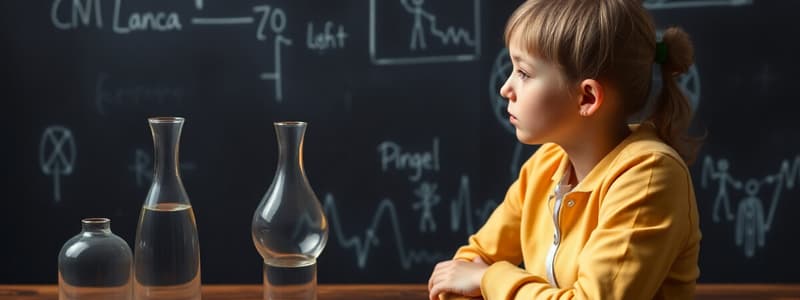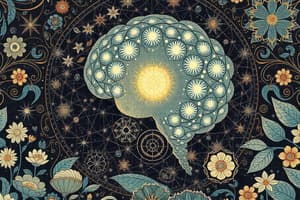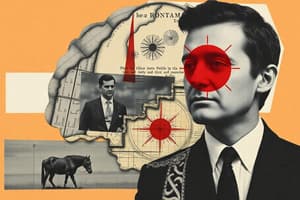Podcast
Questions and Answers
In the context of scientific thinking, why is it important to consider what you don't see, in addition to what you do see?
In the context of scientific thinking, why is it important to consider what you don't see, in addition to what you do see?
- To simplify complex problems by focusing only on directly observable evidence.
- To reinforce initial observations and strengthen existing hypotheses.
- To identify potential biases and hidden variables that might affect outcomes. (correct)
- To confirm personal beliefs and disregard contradictory information.
What characteristic distinguishes science from other human endeavors, regarding the handling of mistakes?
What characteristic distinguishes science from other human endeavors, regarding the handling of mistakes?
- Science attributes mistakes to individual failures rather than systemic issues.
- Science actively seeks, identifies, and corrects its own mistakes. (correct)
- Science avoids making mistakes by adhering strictly to established protocols.
- Science readily accepts mistakes and does not attempt to correct them.
How does the example of Albert Einstein illustrate the nature of scientific progress?
How does the example of Albert Einstein illustrate the nature of scientific progress?
- It exemplifies that in science, evidence-based correctness can supersede status and prior achievements. (correct)
- It demonstrates that scientific authority is based on personal connections and reputation.
- It shows that established scientists are always given more credibility, regardless of evidence.
- It highlights that scientific debate is won through popularity and convincing rhetoric.
A researcher conducts a study on the effects of a new teaching method but only publishes results that support its effectiveness. What aspect of scientific integrity is the researcher neglecting?
A researcher conducts a study on the effects of a new teaching method but only publishes results that support its effectiveness. What aspect of scientific integrity is the researcher neglecting?
Why should one approach reports and findings in scientific literature with critical thinking?
Why should one approach reports and findings in scientific literature with critical thinking?
What is the central idea presented regarding the scientific method's effectiveness?
What is the central idea presented regarding the scientific method's effectiveness?
How did Sir Francis Bacon contribute to the development of modern science?
How did Sir Francis Bacon contribute to the development of modern science?
Why does the text compare human behavior to that of an armadillo?
Why does the text compare human behavior to that of an armadillo?
According to the content, which factor most significantly hampers critical thinking when evaluating evidence?
According to the content, which factor most significantly hampers critical thinking when evaluating evidence?
What underlying assumption does the content make about human cognition?
What underlying assumption does the content make about human cognition?
What does the content suggest regarding educational programs designed to improve critical thinking skills?
What does the content suggest regarding educational programs designed to improve critical thinking skills?
Which statement summarizes a key premise about using empirical evidence?
Which statement summarizes a key premise about using empirical evidence?
How did Sir Francis Bacon's approach to science differ from previous methods?
How did Sir Francis Bacon's approach to science differ from previous methods?
What initial action do people take when presented with evidence that supports their pre-existing beliefs?
What initial action do people take when presented with evidence that supports their pre-existing beliefs?
In the study involving the girl named Hannah, how did participants' pre-existing beliefs about her background influence their assessment of her academic abilities?
In the study involving the girl named Hannah, how did participants' pre-existing beliefs about her background influence their assessment of her academic abilities?
How do personal preferences and prejudices affect our interpretation of evidence?
How do personal preferences and prejudices affect our interpretation of evidence?
In the study about the death penalty, how did the participants' initial views on the subject influence their interpretation of mixed evidence?
In the study about the death penalty, how did the participants' initial views on the subject influence their interpretation of mixed evidence?
What is one way in which beliefs and desires shape our view of evidence?
What is one way in which beliefs and desires shape our view of evidence?
What does the text suggest about the standards people apply when evaluating evidence that supports their beliefs versus evidence that contradicts them?
What does the text suggest about the standards people apply when evaluating evidence that supports their beliefs versus evidence that contradicts them?
How do people's social circles typically influence their beliefs and desires?
How do people's social circles typically influence their beliefs and desires?
What searching behavior does the text attribute to people when seeking evidence related to their beliefs and desires?
What searching behavior does the text attribute to people when seeking evidence related to their beliefs and desires?
What does the text imply about the interpretation of evidence?
What does the text imply about the interpretation of evidence?
What primary rule of critical thinking does the text emphasize, given our tendency to see what we expect or want to see?
What primary rule of critical thinking does the text emphasize, given our tendency to see what we expect or want to see?
What is one of the best ways to find the truth about the world?
What is one of the best ways to find the truth about the world?
Based on the information provided, how do Facebook 'echo chambers' affect a user's perspective?
Based on the information provided, how do Facebook 'echo chambers' affect a user's perspective?
Which question do we tend to ask ourselves when evaluating evidence that contradicts our beliefs, according to the text?
Which question do we tend to ask ourselves when evaluating evidence that contradicts our beliefs, according to the text?
Why might differing survey questions impact the relationship between education and happiness?
Why might differing survey questions impact the relationship between education and happiness?
Why is it challenging to doubt your own conclusions?
Why is it challenging to doubt your own conclusions?
Why do scientists often share their findings with colleagues who are likely to disagree with them?
Why do scientists often share their findings with colleagues who are likely to disagree with them?
What is the central point of Francis Bacon's story about the Roman temple?
What is the central point of Francis Bacon's story about the Roman temple?
What did Bacon identify as 'the greatest impediment and aberration of the human understanding'?
What did Bacon identify as 'the greatest impediment and aberration of the human understanding'?
In the study involving trigrams (three-letter combinations), what critical difference was observed when participants were asked to identify the 'special' trigram?
In the study involving trigrams (three-letter combinations), what critical difference was observed when participants were asked to identify the 'special' trigram?
What general principle does the example of businesses providing testimonials from satisfied customers illustrate?
What general principle does the example of businesses providing testimonials from satisfied customers illustrate?
What conclusion might someone draw from the bar graph showing hours spent partying at Canadian universities, and why might that conclusion be incorrect?
What conclusion might someone draw from the bar graph showing hours spent partying at Canadian universities, and why might that conclusion be incorrect?
Why is it important to examine the scatterplot showing the relationship between hours spent partying and studying, in addition to the bar graph showing hours spent partying?
Why is it important to examine the scatterplot showing the relationship between hours spent partying and studying, in addition to the bar graph showing hours spent partying?
In the context of the WWII planes, what critical insight did Alexander Wald provide regarding the bullet hole data?
In the context of the WWII planes, what critical insight did Alexander Wald provide regarding the bullet hole data?
What key question should one ask to apply critical thinking in evaluating claims or evidence?
What key question should one ask to apply critical thinking in evaluating claims or evidence?
What does the example of the WWII planes and the advice of mathematician Alexander Wald teach us about data analysis?
What does the example of the WWII planes and the advice of mathematician Alexander Wald teach us about data analysis?
How does the concept of considering 'what you don't see' relate to the scientific process?
How does the concept of considering 'what you don't see' relate to the scientific process?
What is the potential consequence of ignoring the rule to consider what you don't see, as highlighted in both the trigram study and the university partying example?
What is the potential consequence of ignoring the rule to consider what you don't see, as highlighted in both the trigram study and the university partying example?
Which statement best summarizes the relationship between critical thinking and the consideration of missing evidence?
Which statement best summarizes the relationship between critical thinking and the consideration of missing evidence?
How does the principle of considering 'what you don't see' apply to evaluating marketing and advertising claims?
How does the principle of considering 'what you don't see' apply to evaluating marketing and advertising claims?
Consider a study concluding that students who study at least 3 hours per day achieve higher grades. What 'missing evidence' should a critical thinker consider before accepting this conclusion?
Consider a study concluding that students who study at least 3 hours per day achieve higher grades. What 'missing evidence' should a critical thinker consider before accepting this conclusion?
Flashcards
Scientific Method
Scientific Method
A method for discovering facts about the natural world, developed by Sir Francis Bacon.
Empirical Evidence
Empirical Evidence
Evidence gathered through observation or experimentation.
Critical Thinking
Critical Thinking
Analyzing evidence in an unbiased way and considering the whole truth.
Cognitive Biases
Cognitive Biases
Signup and view all the flashcards
Confirmation Bias
Confirmation Bias
Signup and view all the flashcards
Ignoring Unseen Evidence
Ignoring Unseen Evidence
Signup and view all the flashcards
Anchoring Bias
Anchoring Bias
Signup and view all the flashcards
Bacon's Insight
Bacon's Insight
Signup and view all the flashcards
Science's Self-Correction
Science's Self-Correction
Signup and view all the flashcards
Science as a Democracy
Science as a Democracy
Signup and view all the flashcards
Psychological Science
Psychological Science
Signup and view all the flashcards
Critical Stance
Critical Stance
Signup and view all the flashcards
Skeptical Inquiry
Skeptical Inquiry
Signup and view all the flashcards
Wishful Thinking Bias
Wishful Thinking Bias
Signup and view all the flashcards
Selective Exposure
Selective Exposure
Signup and view all the flashcards
Biased Evidence Evaluation
Biased Evidence Evaluation
Signup and view all the flashcards
Echo Chambers
Echo Chambers
Signup and view all the flashcards
Doubt Your Conclusions
Doubt Your Conclusions
Signup and view all the flashcards
Seek Opposing Views
Seek Opposing Views
Signup and view all the flashcards
Attitude Polarization
Attitude Polarization
Signup and view all the flashcards
Wishful Science
Wishful Science
Signup and view all the flashcards
Search Stopping
Search Stopping
Signup and view all the flashcards
Preferential Search
Preferential Search
Signup and view all the flashcards
Opinions
Opinions
Signup and view all the flashcards
Desire for correctness
Desire for correctness
Signup and view all the flashcards
Human understanding
Human understanding
Signup and view all the flashcards
Conclusion
Conclusion
Signup and view all the flashcards
Criticism in Science
Criticism in Science
Signup and view all the flashcards
Ignoring Invisible Evidence
Ignoring Invisible Evidence
Signup and view all the flashcards
Erroneous Conclusions
Erroneous Conclusions
Signup and view all the flashcards
Consider Missing Evidence
Consider Missing Evidence
Signup and view all the flashcards
Testimonials and Bias
Testimonials and Bias
Signup and view all the flashcards
Partying vs. Studying
Partying vs. Studying
Signup and view all the flashcards
WWII Plane Armouring
WWII Plane Armouring
Signup and view all the flashcards
Wald's Insight
Wald's Insight
Signup and view all the flashcards
Presence vs. Absence
Presence vs. Absence
Signup and view all the flashcards
Survivor Bias
Survivor Bias
Signup and view all the flashcards
Balanced Perspective
Balanced Perspective
Signup and view all the flashcards
Incorrect Assumptions
Incorrect Assumptions
Signup and view all the flashcards
Alexander Wald.
Alexander Wald.
Signup and view all the flashcards
Latent evidence
Latent evidence
Signup and view all the flashcards
The truth.
The truth.
Signup and view all the flashcards
Study Notes
- In 1620, Sir Francis Bacon published "Novum Organum," detailing a new method for discovering facts about the natural world.
- The "Baconian method" is now known as the scientific method.
- The scientific method has facilitated more learning about humanity and the natural world in the last four centuries than in all previous centuries combined.
- Critical thinking involves questioning whether evidence has been interpreted without bias and whether it represents the whole truth.
- Research indicates that most people struggle with critical thinking.
Natural Human Tendencies
- Natural human tendencies that once served humans well in hunter-gatherer societies may no longer be beneficial in today's complex societies.
- Sir Francis Bacon argued that the tendencies to see what we expect/want and to ignore what we can't see are major obstacles to critical thinking.
Seeing What We Expect and Want to See
- People often draw different conclusions from the same evidence due to pre-existing beliefs.
- Beliefs can color views of new evidence, causing individuals to see what they expect.
- A study showed that participants who believed a girl named Hannah was from an affluent family rated her academic performance more positively than those who believed she was from a poor family, even when watching the same video.
- Views of evidence are also colored by preferences, prejudices, ambitions, aversions, hopes, needs, wants, and dreams.
- People tend to believe what they want to be true.
- Participants in a study who initially supported the death penalty became more supportive after seeing evidence, while those who opposed it became more opposed, regardless of the evidence presented.
- Facebook users often create "echo chambers" by sharing information primarily with like-minded individuals.
Standards of Evidence
- People hold different types of evidence to different standards.
- Evidence confirming existing beliefs is often assessed with "Can I believe this evidence?", while evidence disconfirming beliefs is assessed with "Must I believe this evidence?".
- People tend to search for evidence that confirms their beliefs and desires.
- When confirmatory evidence is found, the search tends to stop, but when contradictory evidence is found, people keep searching.
- Because it is easy to see what we expect or want to see, the first rule of critical thinking is to doubt your own conclusions.
- Seeking out and listening to those with differing views is one of the best ways to find truth.
Not Considering What We Don’t See
- People rarely pay attention to what is missing, and this natural tendency can impede human understanding.
- A study showed participants could not identify that trigrams lacking the letter T were "special", but could identify trigrams containing the letter T.
- The second rule of critical thinking is to consider what you don’t see.
Erroneous Conclusions
- Ignoring missing evidence can lead to drawing erroneous conclusions.
- A bar graph showing partying habits at Canadian universities led to incorrect assumptions about Queen's University until study habits were also considered.
- During World War II, mathematician Alexander Wald advised armoring plane engines rather than fuselages, considering the planes that didn't return and the missing bullet holes in their engines.
- If the first rule of critical thinking is to doubt what you do see, then the second rule is to consider what you don’t see.
The Skeptical Stance
- Humans make mistakes in science, but scientists actively seek to discover and correct these errors.
- Science invites examination and challenges to conclusions, and scientists strive for accuracy and rigor.
- Science is the ultimate democracy, where anyone, regardless of background, can challenge established ideas.
- Albert Einstein's victory in a scientific debate was due to his correctness.
- Chapters in textbooks serve as reports from psychological scientists, using the scientific method to uncover truths about human existence.
Studying That Suits You
Use AI to generate personalized quizzes and flashcards to suit your learning preferences.




